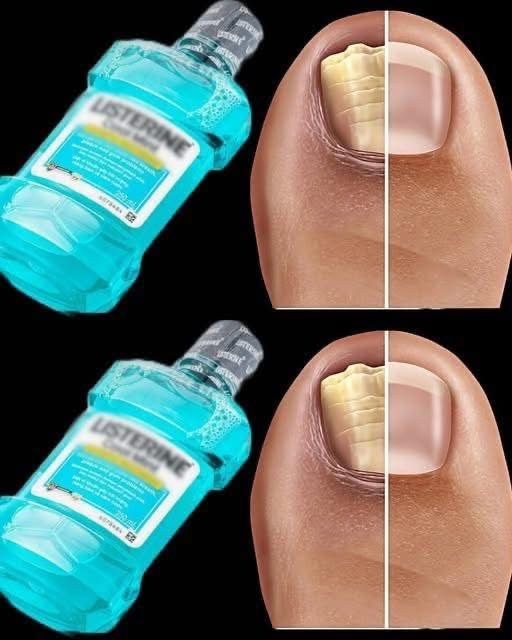Nail fungus is one of those health annoyances that seems minor—until it happens to you. It often starts as a small, almost unnoticeable change: a tiny yellow spot under the nail, a bit of thickening, or a brittle edge. Left untreated, it can spread, warp the nail, and make simple tasks—like putting on socks—painful. Millions of people worldwide deal with this stubborn condition, and the frustration isn’t just cosmetic. Nail fungus can be difficult and expensive to treat. While pharmacies are stocked with antifungal creams, tablets, and nail solutions, many take months to show results, and not everyone wants to rely on prescription medications. That’s where an inexpensive, surprisingly simple home remedy comes in: mouthwash.
At first, it may sound odd. Mouthwash is meant to freshen your breath, not heal toenails. But when you look at the ingredients, it makes sense. Compounds like eucalyptol, menthol, and thymol—used to kill bacteria in the mouth—are also effective antifungal agents. Add the alcohol content present in most mouthwashes, and you have a liquid capable of disinfecting and attacking the fungi responsible for nail infections. This isn’t just internet folklore; there’s a scientific rationale behind using an antiseptic rinse on fungal infections.
So how does it work? Nail fungus thrives in dark, damp conditions that regular soap and water can’t fully penetrate. The antiseptic compounds in mouthwash can seep into cracks around and beneath the nail, disrupting fungal growth and, over time, killing the infection. Alcohol dries out the environment fungi need to thrive, making it harder for the fungus to spread. Unlike some harsh chemicals, mouthwash is formulated for safe use in the human body, making it generally safe for external application on nails and surrounding skin.
Using mouthwash as a nail fungus remedy is straightforward. A common method is to soak the affected nails in a small basin of mouthwash for 15 to 20 minutes daily. Some people mix equal parts mouthwash and vinegar, as vinegar’s acidity adds antifungal benefits. Others simply apply mouthwash directly to the nail with a cotton ball several times a day. The key is consistency—fungal infections don’t vanish overnight. With steady use, mouthwash can help reduce discoloration, soften thickened nails, and prevent the infection from spreading to other toes or fingers.
Compared with prescription antifungal medications, which may cause side effects such as liver strain or digestive upset, mouthwash is inexpensive, accessible, and low-risk. A single bottle costs only a few dollars, and most people already have some in their bathroom. For those seeking a natural first-line treatment or a complementary approach alongside conventional therapy, mouthwash is an appealing option.
There are, of course, limitations. Severe infections or those affecting multiple nails may not respond fully to mouthwash, and professional medical treatment might be necessary. Additionally, nails grow slowly, so even if the fungus is eliminated, it may take months for a healthy new nail to replace the damaged one. Patience is part of the process.
Preventive habits are equally important. Fungal nail infections thrive in warm, moist environments—think public showers, sweaty shoes, and swimming pools. Regularly washing and thoroughly drying your feet, wearing breathable shoes, and trimming nails correctly can greatly reduce the risk of infection. Even adding a weekly mouthwash soak as a preventive measure can help.
It’s remarkable to think that a simple household product, originally designed for oral hygiene, can double as an antifungal treatment. While clinical research on mouthwash for nail fungus is still limited, numerous anecdotal success stories suggest it’s worth trying before investing in more expensive or invasive treatments.
Ultimately, nail fungus can be persistent, but it doesn’t always have to be expensive or stressful. With patience, creativity, and a bit of antiseptic mouthwash, the solution may be hiding in plain sight all along.
